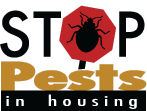- HOME
- » Frequently Asked Questions
- » How do you treat a home where residents have respiratory problems?
How do you treat a home where residents have respiratory problems?
IPM is all about site-specific controls. “Treat” doesn’t necessarily mean using pesticides. Know what kind of pest you’re dealing with, how bad the infestation is, and where the pests are found. The health of the residents in the home is part of what the PMP needs to take into consideration when planning the control program (the “treatment”). If there is a concern with pesticides or a reasonable accommodation request, give the resident's physician a copy of the pesticide label and MSDS and get the doctor's approval. For residents with respiratory problems, consider the following options.
Cockroaches
Focus the most effort on reducing sources of water. Fix leaks, keep dishes clean and dry at night, and dry in and around sinks and showers after use in the evening. Have the resident make a practice of covering drain openings with a dry towel at night to prevent cockroaches from going into the drain to find water. Other water sources to consider are plant pots, flower vases, pet bowls, refrigerator drip pans, and AC units. Of course, cleaning up cockroach food sources is good too. The PMP should rely on gel baits for cockroach control in homes where a resident with a respiratory problem lives. Clean up of dead cockroaches with a vacuum that has a HEPA filter.
Mice
Mice don’t need to drink water, so keeping food secure is more important than limiting water sources. The PMP or resident should use nonchemical traps such as snap traps or glue boards to kill the mice. If many droppings are found, spray them with a bleach solution (according to the label directions) and wipe them up with a paper towel or rag. This prevents disease-carrying particles from going airborne.
Bed Bugs
If a resident with respiratory problems lives in a building with bed bugs, consider putting encasements on the box spring and mattress and installing insect interceptor monitors under bed frame legs before an infestation is detected. Have the resident keep the bed a few inches away from the wall and from any bedside furniture. This will help with early detection and the interceptors may catch the one or two bed bugs that are introduced before they have a chance to infest.
Bed bug control is tricky when the resident has a respiratory problem because few non-spray or dust formulation pesticides exist for bed bugs. If the infestation is detected while it is still small, a trained applicator can use steam while the resident uses a clothes dryer on high heat to rid fabric of bed bugs. The resident should put a bed bug-proof mattress encasement on both the mattress and the box spring after they have dried from steaming. Some items that can’t be steamed or go in a drier can be heated using a portable chamber. If the infestation is bad and the resident cannot tolerate the pesticides used for bed bugs, consider a whole-unit heat treatment. If pesticides are used, the PMP may advise that the resident stay out of the unit for an extended period (more than 4 hours) after the application.
